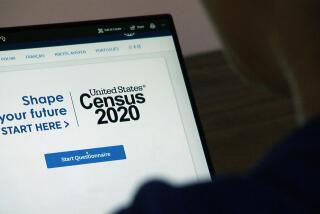1990 Census--a Window on Our Changing Society
So, how much money do you make? How much is your house worth? Anybody live there with you? Are you married or just living together? The other person, male or female?
Ah, the census. As it does every 10 years, the federal government is beginning to canvass the citizenry, seeking shifts in population and insight into the patterns of American life.
With a budget of $2.6 billion and a temporary work force of more than 400,000, the Census Bureau is striving to place questionnaires in 106 million households. The bureau mailed most of the forms this week. Others go out by courier, bush plane, snowmobile, dog sled and horseback. Census takers already have visited a number of villages in Alaska and earlier this week targeted the nation’s homeless population. In April and May, they will attempt to visit every household in the nation that did not return a census form.
The task of canvassing 250 million Americans is supposed to be completed by October.
Five out of six U.S. households will receive a short form, which asks 14 questions on personal characteristics and housing and is supposed to take just 15 minutes to complete.
The rest will be saddled with a form that contains 45 additional questions and is considerably more probing, with detailed questions about income, ancestry, occupation, military service, education, living arrangements, physical disabilities, housing costs and working habits.
How many bedrooms do you have in your house? the long form asks. How many cars do you own? How much schooling have you had? How well do you speak English? When did you last work?
Recipients are required by law to fill out the forms. Scofflaws face a $100 fine.
The census forms contain toll-free telephone numbers for people who have questions or need foreign-language assistance. But on Friday, the English- and Spanish-language telephone lines were flooded with inquiries and many callers got only busy signals. The Asian-languages information lines did not experience as much congestion.
The Census Bureau expects to begin releasing information culled from the forms early next year. But the bureau, which operates under the Commerce Department, pledges that the specific answers people give are confidential, safe from the prying eyes of the FBI or even the IRS. Courts have upheld that pledge.
First taken in 1790, the census is required by the Constitution, primarily for the purpose of apportioning members of the U.S. House of Representatives among the states according to population.
Over the years, the census has become an indispensable tool for allocating government money. Nearly $40 billion in federal aid, or 35% of all grant outlays, is distributed to local governments based on population, age and income data supplied by the census. Local governments use the data in deciding where to build schools, fire stations, day-care centers, roads and hospitals.
Businesses can acquire the information and use it to help identify their markets. The census tells them who their customers are, where they live and how they are changing.
For 200 years, the census has provided a window on a changing society. The 1890 census documented the disappearance of the American frontier--the country had been homesteaded from sea to shining sea. The 1920 census, noting that most Americans were living in cities, marked the country’s change from an agrarian to an urban society. The 1950 census revealed that women had come to outnumber men. The 1970 census showed that for the first time more than half the adult population had finished high school.
Indications are that the 1990 census will underscore the continuing concentration of population and political power in the West.
In preparing for the current counting, the Census Bureau spent eight years trying to come up with the set of questions that would reflect important social trends. The Census Bureau held more than 100 hearings around the country and rejected scores of suggested questions on matters ranging from religious affiliation to the number of dogs and cats in each household, to the number of back yard swimming pools.
A psychiatric organization unsuccessfully promoted the idea of asking people whether they dream in color.
Over the years, the Census Bureau has dropped some of the more indelicate questions from its forms. At the end of the previous century, if a child was thought to be homeless, a census taker was supposed to ask: “Has the origin of the child been respectable?”
“The census always has reflected society’s current concerns,” said Maury Cagle, the bureau’s acting director of public information.
In the 1880s, Cagle said, “Society wanted to know just how large a problem mental illness was. Census takers were instructed to ask people ‘do you have an idiot in the house?’ If the answer was ‘yes,’ the census taker was to take a tape measure and measure the size of his or her skull.”
Cagle said that the 1880 census asked for so much information that the Census Bureau was still tabulating it 10 years later when the 1890 census had started.
The 1990 census does not dwell on any one topic, Cagle said. It just wants to know more about a lot of things.
For example, this year, people who identify themselves as Hispanic will be asked to note their country of origin.
The growing alarm over traffic congestion and air pollution has led to new questions on the long form about commuting time:
How did you get to work last week? What time do you leave for work? How long does it take you to get there? Did you share a ride with anybody?
Concern about the living conditions of elderly people has prompted a question on the short form that will try to determine how many old people are not living either by themselves or in nursing homes.
The 1990 census will attempt to document our changing living arrangements. The questionnaires don’t ask people to state their sexual preferences, but census forms, for the first time, leave a place for couples living together to identify themselves as “unmarried partners.” Comparing that information with the gender of respondents, the census will be able to calculate the number of gay couples in the United States.
Spanning the two centuries of this nation’s existence, the census has become a strange hybrid--part abacus, part computer.
This year, the Census Bureau proudly unveiled its TIGER File. Short for Topographically Integrated Geographic Encoding and Referencing, TIGER is a computerized mapping system capable of instantly characterizing any neighborhood in America in terms of the rate of home ownership, age, race, family size, median income and education.
With the TIGER File, which can be bought on compact discs, the task of pinpointing population groups or market segments--a job that once took months of sorting through geographic data and hand-printed maps--can now be done in seconds.
Meanwhile, the Census Bureau insists on counting people the old-fashioned way, one at a time, employing essentially the same technique to count 250 million people that it used in 1790 to count 4 million. Even then, George Washington was convinced that the census had missed a lot of people.
After the 1980 census, the Census Bureau admitted to missing about 3 million people, almost as many as were counted in 1790. Yet, to the consternation of many demographers, the bureau has resisted pressure to employ more sophisticated methods of calculating the number of people based on random sampling of various population segments.
The Census Bureau currently is embroiled in a lawsuit over the issue.
One question on the census long form speaks volumes about old habits at the Census Bureau.
In an age of spas and Jacuzzis and basement lap pools, the census form still wants to know if you have indoor plumbing.
A DIVERSE CONSTITUENCY
Above, examples of U.S. Census promotional materials printed in Spanish, Korean, Chinese and Vietnamese. Below are census hot line numbers for assistance in a variety of languages. Calls are toll-free and assistance will be available from March 23 to April 15 between the hours of 9 a.m. and 9 p.m.
English: 1-800-999-1990
Spanish: 1-800-283-6826
Korean: 1-800-444-6205
Cambodian: 1-800-289-1960
Chinese: 1-800-365-2101
Vietnamese: 1-800-937-1953
Loatian: 1-800-888-3208
Thai: 1-800-288-1984
More to Read
Sign up for Essential California
The most important California stories and recommendations in your inbox every morning.
You may occasionally receive promotional content from the Los Angeles Times.






